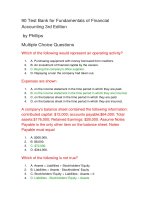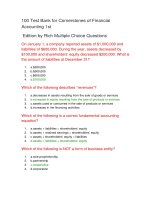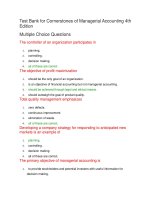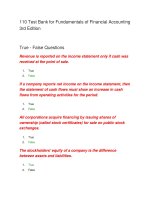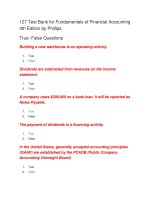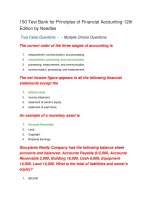Test bank for cornerstones of financial accounting 2nd edition by rich jones women hansen jones tassone 1
Bạn đang xem bản rút gọn của tài liệu. Xem và tải ngay bản đầy đủ của tài liệu tại đây (236.06 KB, 79 trang )
Test Bank for Cornerstones of Financial Accounting 2nd edition by Jay
Rich, Ralph Tassone, Donald Jones, Don Hansen, Maryanne Mowen,
Jefferson Jones
Link full download testbank:
/>Link full download Soluiton Manual:
/>
Chapter 2 The Accounting Information System and
Financial
Statements
TRUEFALSE
1. The time period assumption assumes that a company prepares its financial statements
every month.
(A) True
(B) False
Answer : (B)
2. Because it tends to provide the most reliable measure of activity, all assets are reported
on the balance sheet at their fair market values.
(A) True
(B) False
Answer : (B)
3. As long as a company keeps a record of supporting calculations, recorded amounts are
verifiable.
(A) True
(B) False
Answer : (B)
4. The going-concern assumption infers that a company will continue to operate into the
near future.
(A) True
(B) False
Answer : (A)
5. A company expected to go bankrupt in the near future is considered to be operating
under the going-concern assumption.
(A) True
(B) False
Answer : (B)
6. For each transaction, the number of accounts debited must equal the number of
accounts credited. (A) True
(B) False
Answer : (B)
7. The initial step in the accounting cycle is to journalize transactions.
(A) True
(B) False
Answer : (B)
8. When a company issues (i.e., sells) common shares to investors in exchange for cash,
the effect of this transaction is an increase in assets and an increase in shareholders'
equity. (A) True
(B) False
Answer : (A)
9. Because dividends are a distribution of a company's net income, they are recorded as an
adjustment to net income.
(A) True
(B) False
Answer : (B)
10. According to the historical cost principle, assets are measured at the exchange price at
the time the activity occurs.
(A) True
(B) False
Answer : (A)
11. An accounting transaction may impact only a single financial statement or multiple
financial statements. (A) True
(B) False
Answer : (A)
12. The accounting equation must be in balance before and after every accounting
transaction.
(A) True
(B) False
Answer : (A)
13. A chart of accounts is prepared to determine whether the accounting records have
gotten out of balance. (A) True
(B) False
Answer : (B)
14. A company's chart of accounts can be changed over time as the nature of the business
activities change.
(A) True
(B) False
Answer : (A)
15. A T-account for Cash cannot contain any credits.
(A) True
(B) False
Answer : (B)
16. A debit entry increases assets and revenue accounts.
(A) True
(B) False
Answer : (B)
17. The Dividends Declared account has a normal debit balance.
(A) True
(B) False
Answer : (A)
18. Under the double-entry system of accounting, every transaction affects at least two
accounts.
(A) True
(B) False
Answer : (A)
19. Under the double-entry system of accounting, a debit represents a decrease to
a liability account. (A) True
(B) False
Answer : (A)
20. Income statement accounts affect Retained Earnings.
(A) True
(B) False
Answer : (A)
21. When an event impacts a financial statement element, it should be recognized in the
accounting records even if reliability of the amount is questionable.
(A) True
(B) False
Answer : (B)
22. The process of transferring information from the general ledger to the general journal is
called posting.
(A) True
(B) False
Answer : (B)
23. The accounting cycle differs depending on whether a company uses IFRS or ASPE
accounting standards. (A) True
(B) False
Answer : (B)
24. A trial balance is the listing of each active account and its corresponding debit or credit
balance at a particular point in time.
(A) True
(B) False
Answer : (A)
25. Even though a trial balance reveals that the debits equal the credits, there may still be
errors in the company's books.
(A) True
(B) False
Answer : (A)
26. Depreciation is to IFRS as amortization is to ASPE.
(A) True
(B) False
Answer : (A)
27. It is necessary to account for company transactions separately from personal
transactions of the owner only if the company has more than one shareholder.
(A) True
(B) False
Answer : (B)
28. The full disclosure principle requires that all information that would make a difference
to financial statement users should be revealed.
(A) True
(B) False
Answer : (A)
29. If a company performed services for credit, then the debit side of the journal entry
would be to accounts payable and the credit would be to service revenue.
(A) True
(B) False
Answer : (B)
30. If a company made a payment on account, then assets and liabilities would both
decrease.
(A) True
(B) False
Answer : (A)
SHORTANSWER
31.The ____________________ of accounting is designed to support the development of a
consistent set of accounting standards and provide a consistent body of thought for
financial reporting.Answer :
Conceptual framework
32.The concept that assumes that assets are recorded at the amount paid to acquire them
is called the ____________________ principle.Answer : historical cost
33.The concept that assumes that an entity is NOT in the process of bankruptcy is called
the
___________ concept.Answer : going-concern (or "continuity")
34.The __________________ includes the sequence of procedures used to transform the
effects of a company's activities into financial statements.Answer : accounting cycle
35.Information is _____________ if it adds either predictive or confirmatory value to help
users make business decisions.Answer : relevant
36.____________________ is the magnitude of an omission or misstatement in accounting
information that could influence the decision of someone relying on the
information.Answer : Materiality
37.____________________ is the capacity of information to make a difference in a decision by
helping make timely predictions of future events or providing feedback about prior
expectations.Answer :
Relevance
38.Accounting should be a(n) ____________________ representation of the real-world
economic event that it is intending to portray.Answer : faithful
39.Information is ____________________ if it is available to users before it loses its ability to
influence business decisions.Answer : Timely
40.____________________ is the quality of accounting information that allows a user to
analyze two or more companies and look for similarities and differences.Answer :
Comparability
41.____________________ is the quality of accounting information that involves applying the
same accounting principles to allow a user to compare two or more accounting periods
for a single company, or multiple companies for a single accounting period.Answer :
Consistency
42.In order for an internal or external event to be ____________________ in an accounting
system, the items making up the event must impact a financial statement element and
they must be measured with sufficiently reliability.Answer : recognized/recorded
43.____________________ documents provide the evidence needed in an accounting system
to support the recording of transactions.Answer : Source
44.Receipt of cash as advance payment from a customer for services not yet performed
has the effect of increasing both assets and __________.Answer : liabilities
45.Borrowing from the bank in order to acquire computer equipment for $1,500 has the
effect of increasing both assets and ____________________.Answer : liabilities
46.If a law firm provides services on account for its clients, both ____________________ and
retained earnings will increase.Answer : assets
47.The payment of salaries to employees will result in a debit to an expense account and a
credit to the ___________ account.Answer : cash
48.The ____________________ principle says that assets of a company are initially recorded at
their original cost.Answer : historical cost
49.The ____________________ is a list of all the accounts used by an entity.Answer : chart of
accounts
50.The ____________________ is the file or book that contains all of the company's
accounts.Answer : general ledger
51.The ____________________ side, or left side, of a liability account is used to record
decreases in the account balance.Answer : debit
52.For assets and expenses, a credit will _______ the balance in the account.Answer :
decrease
53.For liabilities, shareholders' equity, and revenue accounts, debits will _____________ the
account balance.Answer : decrease
54.Credits are always on the ____________________ side of a T-account.Answer : right
55.A revenue account has a normal ___________ balance.Answer : credit
56.The ___________________ is a chronological record of transactions entered into by a
business.Answer : journal
57.The ___________________ is a list of each active account and its debit or credit balance at
a specific point in time.Answer : trial balance
MULTICHOICE
58. Which of the following statements describes an economic event from an accounting
perspective?
(A) The signing of a service contract is an example of an external event that should usually
be recorded in the accounting records.
(B) Every event that affects an entity should be recorded in the accounting records.
(C) Internal events affect the accounting records; external events do not.
(D) External events involve exchanges between an entity and another entity outside the
company.
Answer : (D)
59. Which of these underlying assumptions for the conceptual framework is the reason the
dollar is used when preparing financial statements?
(A) separate entity
(B) continuity
(C) time period
(D) monetary unit
Answer : (D)
60. Which of the following is a valid assumption from an accounting perspective?
(A) Financial statements are prepared for a specific entity that is distinct from the entity's
owners.
(B) Financial statements should be prepared on a calendar-year basis.
(C) A company that has declared bankruptcy is referred to as a going concern.
(D) The results of customer satisfaction surveys should be reported in the financial
statements because such results could impact decisions of financial statement users.
Answer : (A)
61. For which of the following reasons is the time-period assumption necessary?
(A) Inflation exists and causes confusing swings in financial statement amounts over time.
(B) External users of financial statements want accurately reported net income for a
specific fiscal year.
Financial statement users expect full disclosure of all economic events throughout the
entire time period.
(D) The federal government requires companies to report financial results each calendar
year.
Answer : (B)
62. Which of the following statements is characteristic of assets?
(A) Assets are measured using a time-period approach.
(B) Assets are initially recorded at market value and then adjusted for inflation.
(C) Assets are initially recorded using the historical cost principle.
(D) Assets are initially recorded at market value, since historical cost tends to be too
arbitrary.
Answer : (C)
63. Homevestors paid $400,000 at an auction to purchase land that had an appraised
value of $900,000. The next highest bid on the land was $380,000. At what amount should
the land be recorded on the company's current financial statements?
(A) $380,000
(B) $400,000
(C) $500,000
(D) $900,000
Answer : (B)
64. Which of the following statements is characteristic of double-entry accounting?
(A) Transactions should be recorded first in units, then in dollars.
(B) For each transaction, the number of accounts debited must be equal to the number of
accounts credited.
(C) Each recorded transaction will affect at least two accounts.
(D) Each recorded transaction will affect both sides of the accounting equation.
Answer : (C)
65. Which qualitative characteristic of useful information is materiality an aspect of?
(A) faithful representation
(C)
(B) comparability
(C) relevance
(D) timeliness
Answer : (C)
66. What is a simple, orderly process based on a series of steps and conventions used to
record economic events?
(A) financial statements
(B) posting
(C) general ledger
(D) accounting cycle
Answer : (D)
67. Which of the following characteristics must exist for accounting information to be
useful in making informed decisions? (A) internal and relevant
(B) relevant and precise
(C) precise and reliable
(D) relevant and reliable
Answer : (D)
68. What is the term for information if its omission or misstatement could influence a
decision?
(A) conservative
(B) material
(C) relevant
(D) comparable
Answer : (B)
69. Which of the following is the principle of full disclosure concerned with?
(A) Financial statements should include all material information.
(B) All monetary and non-monetary items should be reported in the accounting records.
There should be a detailed disclosure of the effect of each transaction on the accounting
equation.
(D) The company should disclose its full chart of accounts in the financial statement notes.
Answer : (A)
70. Which of the following is a characteristic of the going-concern assumption?
(A) the company's ability to continue operations long enough to carry out its existing
obligations
(B) any information that is capable of influencing the decisions of anyone using the financial
statements
(C) measuring ongoing business activities at their exchange price at the time of the initial
external transaction
(D) disclosing all information in the financial statements that could influence users
Answer : (A)
71. Which of the following statements is characteristic of faithful representation?
(A) Market values are used to record purchase of assets regardless of the amount actually
paid for them.
(B) External events are not recorded in the accounting records.
(C) Management may have a bias to overstate assets and understate liabilities.
(D) Recorded amounts should be as accurate as possible, but may still contain errors.
Answer : (D)
72. Which of the following is an internal event for a business entity?
(A) Caddie salaries are paid by a country club.
(B) Dividends are distributed to a company's shareholders.
(C) Potatoes for making French fries in a fast-food restaurant are purchased.
(D) Products are transferred from the assembly area to the painting station.
Answer : (D)
73. Which of the following is an internal event for a business entity?
(A) A grocery store recognizes losses from spoilage.
(C)
(B) A grocery store runs ads in a local newspaper.
(C) A grocery store purchases produce from a local farmer.
(D) A grocery store sells groceries to customers on credit.
Answer : (A)
74. Which of the following is an internal event for a business entity?
(A) An attorney provides services for clients.
(B) An attorney purchases computer equipment.
(C) A lawyer uses computer equipment to maintain business records.
(D) An attorney receives cash payments from clients who were billed for legal services.
Answer : (C)
75. Which of the following statements is characteristic of transactions?
(A) Only the effects of internal transactions must be recognized and recorded in the
accounting system.
(B) An internal transaction represents a business activity between an entity and its
environment.
(C) Evidence used to record transactions affecting a business entity comes from source
documents.
(D) Only the effects of external events must be recognized, measured, and recorded in an
entity's accounting system.
Answer : (C)
76. Which of the following statements is characteristic of the use of source documents?
(A) Cheques and deposit slips are the main source documents backing up the bank
statement.
(B) Source documents will exist for only material items.
(C) All source documents should have a signature.
(D) There will be no source documents for online transactions.
Answer : (A)
77. What effect does the purchase of office equipment on credit have on the accounting
equation?
(A) Assets and shareholders' equity decrease.
(B) Liabilities increase and shareholders' equity decreases.
Assets and liabilities increase.
(D) Assets and liabilities decrease.
Answer : (C)
78. What effect does the payment of employee salaries (for hours they worked during the
current period) have on the accounting equation?
(A) Assets and shareholders' equity decrease.
(B) Liabilities and shareholders' equity decrease.
(C) Assets decrease and liabilities increase.
(D) Assets increase and liabilities decrease.
Answer : (A)
79. During March, Honeybaked Spam purchased supplies for cash. The supplies will be
used in
April. What effect does this transaction have on the accounting equation at the time the
supplies are purchased?
(A) Assets increase and shareholders' equity decrease.
(B) Assets and liabilities increase.
(C) There is no net effect on the accounting equation, as one asset account increases while
another asset account decreases.
(D) There is no effect on the accounting equation, as the transaction should not be
recognized until April.
Answer : (C)
80. High Point Furniture Company manufactures furniture. High Point is a defendant in a
class action lawsuit related to defective products. It is alleged that serious injuries were
caused by the company's infant high chairs overturning. The outcome of the lawsuit has
not yet been determined, but management is concerned the company may lose the lawsuit
and may have to pay a significant amount in legal fees and damages. Which of the
following statements reflects most appropriate application of qualitative characteristics of
accounting information in this case?
(A) No transaction should be recorded in the accounting records because the lawsuit is not
relevant.
(C)
(B) The lawsuit should at least be disclosed in the notes to the financial statements because
it would be material.
(C) The company is a going concern because of the class action lawsuit.
(D) The lawsuit is a non-monetary transaction so should not be disclosed.
Answer : (B)
81. An investor can use accounting information from two different companies to evaluate
the types and amounts of expenses. What quality does this information possess?
(A) comparability
(B) consistency
(C) neutrality
(D) materiality
Answer : (A)
82. Hunsinger Enterprises purchases many small pieces of office furniture, such as trash
cans, that cost less than $100 each. The company accounts for these items as expenses
when acquired instead of reporting them as property, plant, and equipment on its balance
sheet. The company's accountant states that no accounting principle has been violated.
What is the justification for expensing these furniture items, aside from cost vs. benefit
considerations?
(A) predictive value
(B) materiality
(C) neutrality
(D) verifiability
Answer : (B)
83. Which of the following statements is an example of application of the qualitative
characteristic of consistency?
(A) For expenses, a company uses the same account names as used by its competitors.
(B) A company has elected certain accounting principles that can never be changed.
(C) A company applies the same accounting principles each period.
(D) A company applies the same accounting principles as its competitors.
Answer : (C)
84. What is the impact of material information in accounting?
(A) It will likely affect the judgment of someone relying on the financial statements.
(B) It will not affect the decisions of financial statement users.
It is a non-monetary item that should not be recorded.
(D) It will be reported as a separate line item on the financial statements.
Answer : (A)
85. An accountant is uncertain about the best estimate of an amount for a business
transaction, but expects it will be material. Management decides to disclose the
transaction in the notes to the financial statements. Which of the following qualities is
characterized by this action? (A) comparability
(B) full disclosure
(C) understandability
(D) neutrality Answer : (B)
86. Which of the following is a qualitative characteristic of accounting information?
(A) reliability
(B) cash flow information
(C) accounting principles
(D) reported assets
Answer : (A)
87. A novelties company makes cash sales to customers. What effect does this transaction
have on the accounting equation?
(A) Liabilities and retained earnings increase.
(B) Assets and liabilities increase.
(C) Assets and retained earnings increase.
(D) Assets and liabilities decrease.
Answer : (C)
(C)
88. Two friends launch a new business by each investing $25,000 cash. They are given
shares as evidence of their ownership interest. What effect does this transaction have on
the accounting equation?
(A) Assets and liabilities increase.
(B) Assets and share capital increase.
(C) Liabilities increase and retained earnings decrease.
(D) Assets and liabilities decrease.
Answer : (B)
89. Machinery is purchased on credit. What effect does this transaction have on the
accounting equation?
(A) Assets and liabilities increase.
(B) Assets and shareholders' equity increase.
(C) Liabilities increase and shareholders' equity decreases.
(D) Assets and liabilities decrease.
Answer : (A)
90. A company provided services to customers and then sent them invoices for the
amounts owed. What effect does this transaction have on the accounting equation?
(A) Assets and liabilities increase.
(B) Assets and retained earnings increase.
(C) Liabilities decrease and share capital increases.
(D) Assets and liabilities decrease.
Answer : (B)
91. Hypnosis Institute received payments from customers who had been billed earlier for
services provided. What effect does this transaction have on the accounting equation?
(A) Assets and liabilities increase.
(B) Assets and shareholders' equity increase.
(C) Assets and liabilities decrease.
(D) There is no net effect on the accounting equation.
Answer : (D)
92. Payment is made for machinery purchased previously on credit. What effect does this
transaction have on the accounting equation?
(A) Assets and liabilities increase.
(B) Assets and share capital increase.
(C) Liabilities decrease and retained earnings increase.
(D) Assets and liabilities decrease.
Answer : (D)
93. The telephone bill for the current period is received and recorded, but payment will be
made later. What effect does this transaction have on the accounting equation?
(A) Assets and liabilities increase.
(B) Assets and share capital increase.
(C) Liabilities increase and retained earnings decrease.
(D) Assets and liabilities decrease.
Answer : (C)
94. Payment is made for a previously recorded telephone bill. What effect does this
transaction have on the accounting equation?
(A) Assets and liabilities increase.
(B) Assets and retained earnings increase.
(C) Liabilities increase and contributed decreases.
(D) Assets and liabilities decrease.
Answer : (D)
95. Services are provided for customers who pay for their services immediately. What
effect does this transaction have on the accounting equation?
(A) Assets and liabilities increase.
(B) Assets and retained earnings increase.
(C) Liabilities increase and retained earnings decreases.
(D) Assets and liabilities decrease.
Answer : (B)
96. Dividends are declared and paid to the company's shareholders. What effect does this
transaction have on the company's accounting equation?
(A) Assets and liabilities decrease.
(B) Assets and retained earnings decrease.
(C) Liabilities decrease and retained earnings increase.
(D) Liabilities increase and contributed capital decreases.
Answer : (B)
97. When a firm borrows money, what is one effect on the accounting equation?
(A) decrease in share capital
(B) increase in assets
(C) decrease in liabilities
(D) decrease in assets
Answer : (B)
98. Which of the following statements best describes the effects of recognizing revenue
earned by a business entity?
(A) Assets increase only when cash sales are collected.
(B) Shareholders' equity increases only when credit sales are made.
(C) Assets and shareholders' equity increase when either cash or credit sales are made.
(D) Assets increase and shareholders' equity decrease when either cash or credit sales are
made. Answer : (C)
99. When a firm recognizes expenses incurred, what is one effect on the balance sheet
equation?
(A) Assets will increase.
(B) Liabilities will decrease.
(C) Share capital will increase.
(D) Retained earnings will decrease.
Answer : (D)
100. What effect do revenues and expenses have on the balance sheet equation?
(A) Revenues decrease shareholders' equity; expenses increase shareholders' equity.
(B) Revenues increase shareholders' equity; expenses increase shareholders' equity.
(C) Revenues increase shareholders' equity; expenses decrease shareholders' equity.
(D) Revenues decrease shareholders' equity; expenses decrease shareholders' equity.
Answer : (C)
101. Which of the following transactions does NOT affect total assets?
(A) A bill is received for last month's utilities.
(B) Dividends are paid to shareholders.
(C) Customers are billed for services provided on credit.
(D) New equipment is purchased on credit.
Answer : (A)
102. Which of the following transactions affects total liabilities?
(A) Equipment is purchased for cash.
(B) Services are provided to a customer for credit.
(C) Payment is made on a bank loan.
(D) Common shares are issued.
Answer : (C)
103. A company purchased equipment for $150,000 cash. What is the effect on total
assets?
(A) an increase of $150,000
(B) a decrease of $150,000
(C) no net effect
(D) an increase of $300,000
Answer : (C)
104. A consulting firm provided services last month and billed its client. This month, the
company received payment from the customer. What impact does this month's transaction
have on the accounting equation?
(A) Assets increase and retained earnings decrease.
(B) Assets decrease and retained earnings decrease.
(C) There is no net effect on the accounting equation.
(D) Assets increase and liabilities decrease.
Answer : (C)
105. Which type of account is increased with a debit but represents a decrease in retained
earnings?
(A) Liability
(B) Asset
(C) Revenue
(D) Dividends Declared
Answer : (D)
106. Which of the following statements is characteristic of the accounting cycle?
(A)If a debit entry is made to an account in the general journal, the same account will receive
a credit entry when the amount is posted to the general ledger.
(B)If all transactions are correctly posted to the general ledger, the sum of the accounts with
debit balances should be equal to the sum of the accounts with credit balances.
(C)Posting occurs when numbers in the general ledger accounts are transferred to the general
journal.
(D)If the sum of the debit balances equals the sum of the credit balances, this proves there
were no mistakes made in the accounting records.
Answer : (B)
107. What is the term for the list of all asset, liability, shareholders' equity, revenue,
expense, and dividend accounts used by the company?
(A) general ledger
(B) general journal
(C) chart of accounts
(D) trial balance
Answer : (C)
108. In the trial balance, if the sum of the debits is NOT equal to the sum of the credits,
what does this signify?
(A) There is no concern, because the two amounts are not meant to be equal.
(B) The chart of accounts does not balance.
(C) It is safe to proceed with the preparation of financial statements.
(D) An error was probably made in journalizing or posting transactions or in computing the
account balance.
Answer : (D)
109. What is the chronological record in which transactions are initially recorded?
(A) T-account
(B) chart of accounts
(C) trial balance
(D) journal
Answer : (D)
110. What is a list of all active accounts and their balances at a particular date, which is
used to prove the equality of debits and credits?
(A) chart of accounts
(B) general ledger
(C) journal
(D) trial balance
Answer : (D)
111. What is the process of transferring amounts from the book of original entry into
specific account records?
(A) journalizing
(B) posting
(C) analyzing
(D) classifying
Answer : (B)
112. What is the correct term for the entry made to the left side of a T-account?
(A) debit
(B) credit
(C) post
(D) journal item Answer : (A)
113. What is the process of recording the effect of a transaction into the accounting
records?
(A) analyzing
(B) journalizing
(C) posting
(D) classifying
Answer : (B)
114. What is the term used for the system of accounting in which at least two accounts are
affected in every transaction so that the accounting equation stays in balance?
(A) debit scoring
(B) credit scoring
(C) double-entry accounting
(D) full disclosure accounting
Answer : (C)
115. Which of the following signifies a credit?
(A) The event had a favourable impact on the entity's financial statements.
(B) The event had an unfavourable impact on the entity's financial statements.
(C) The event had an effect on the right side of the T-account.
(D) The event increased the account balance.
Answer : (C)
116. When the amount for an entry on the left column in a journal is transferred to a
specific account in the general ledger, which of the following must it be posted as?
(A) debit to the account in the general ledger
(B) credit to the account in the general ledger
(C) total amount, without regard to debit or credit
(D) decrease to the account in the general ledger
Answer : (A)
117. What is the correct term for the entry made to the right side of a T-account?
(A) debit
(B) credit
(C) increase
(D) decrease
Answer : (B)
118. Which of the following will NOT cause a trial balance to be out of balance?
(A) A credit entry was posted in the wrong account, but still as a credit.
(B) A debit entry was posted as a credit.
(C) The balance for the account was incorrectly computed.
(D) An account was accidentally omitted from the trial balance.
Answer : (A)
119. Which of the following statements are true?
(A) Debit entries increase asset accounts.
(B) Debit entries increase liability accounts.
(C) Debit entries increase share capital.
(D) Debit entries increase retained earnings.
Answer : (A)
120. Which of the following statements are true?
(A) Credit entries increase asset accounts.
(B) Credit entries increase liability accounts.

